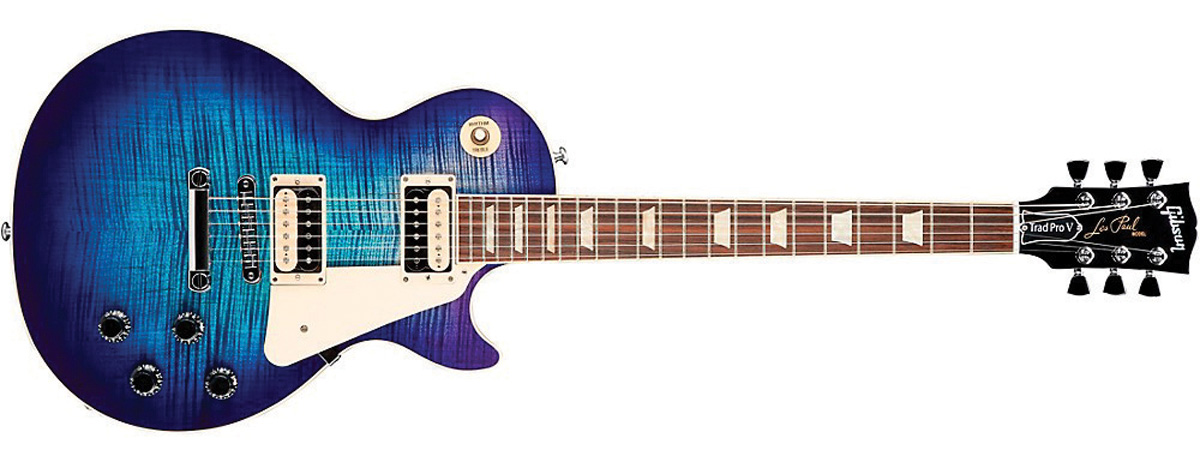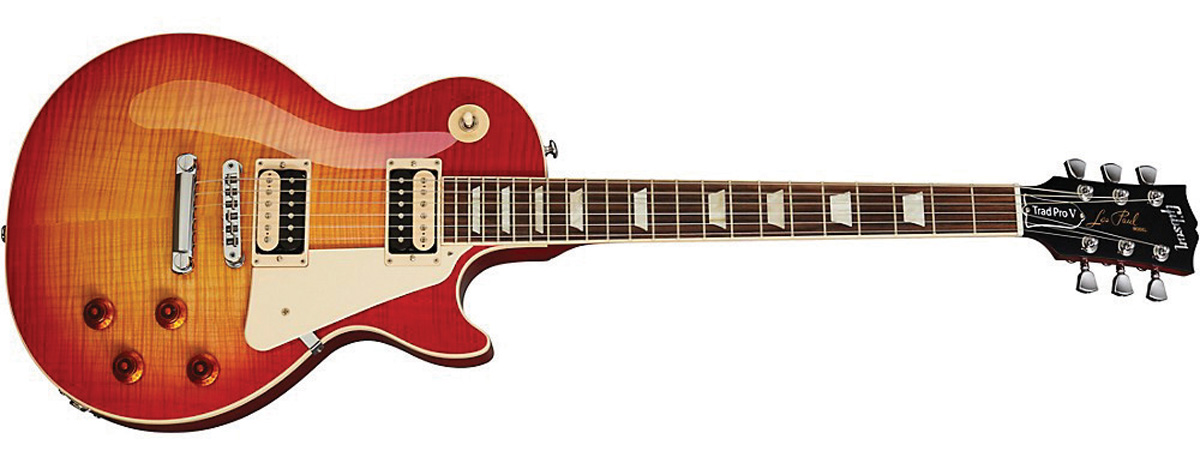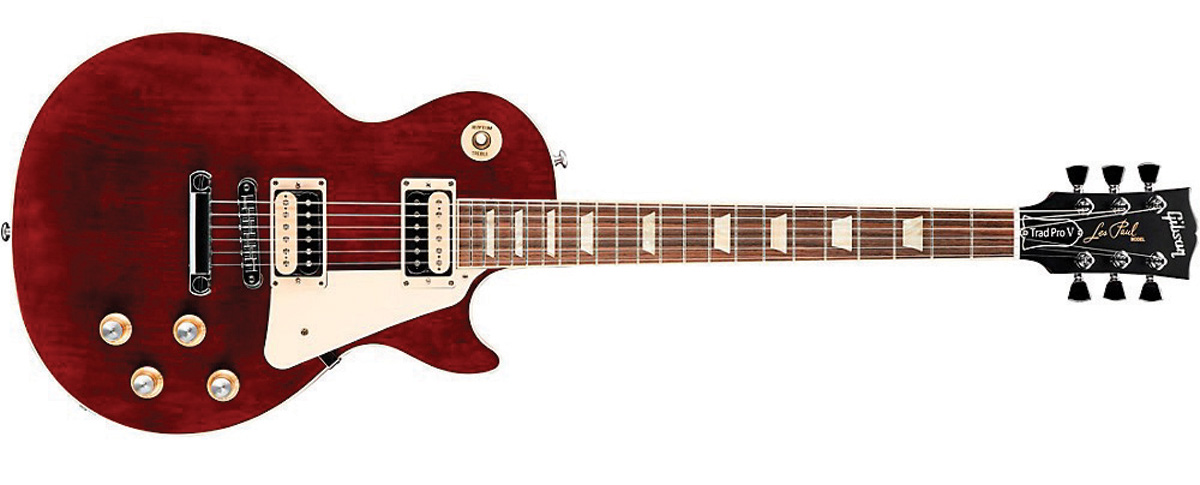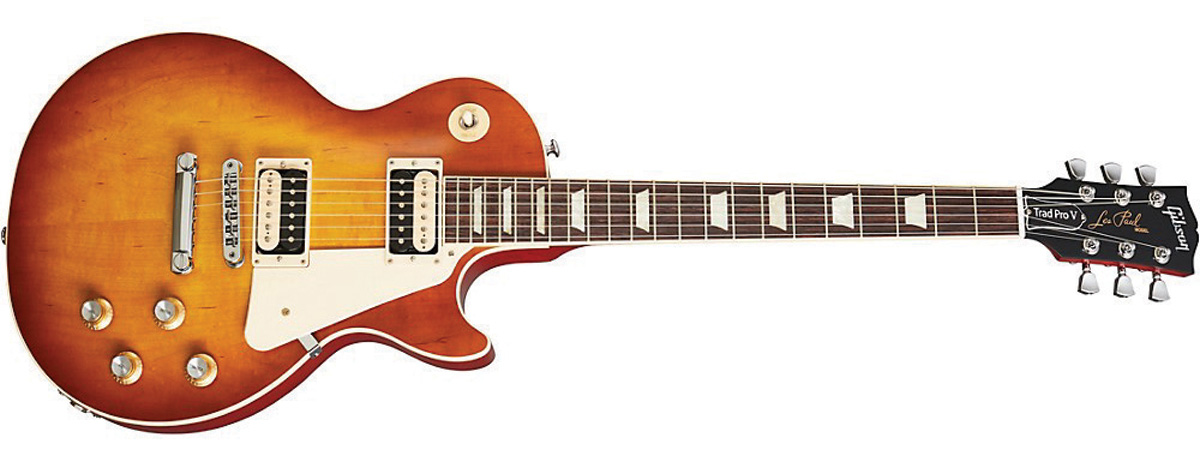GuitarPlayer Verdict
Whether you plump for the high-gloss or satin option, these Les Pauls offer a very respectable range of classic tones, and a playability that is hard to quit.
Pros
- +
They are both great-sounding Les Pauls.
- +
Both play well and feature a ton of sounds.
- +
The Pro V is a good weight.
Cons
- -
None, except the toggle switch had a tendency to slip out of the neck position (Gibson will replace at no charge).
- -
The Satin model is quite heavy.
You can trust Guitar Player.
The Traditional Pro V is the fifth and latest model in a line of Les Pauls that have been developed over the years by Gibson and Guitar Center, and are therefore available only from those companies. It’s the most advanced model thus far and is designed to bring exceptional versatility and playability to this carved-top classic.
The Trad Pro V (as it’s labeled on the truss-rod cover) is available in two distinct finishes: gloss lacquer over a striped maple top in Washed Cherry Burst or Blueberry Burst, or as the Trad Pro V Satin, which wears a matte finish over a plain maple top in Satin Iced Tea or Satin Wine Red.
Otherwise, these Les Pauls are identically equipped, and since Gibson thoughtfully sent us both versions to check out, we’ll make comparisons as needed to point out where they differ in other areas besides finishes. A good place to start is the price. The Pro V Satin comes in at $1,900 versus $2,799 for the Pro V – a whopping $899 difference.
Both models have an asymmetric neck profile developed by Gibson and Guitar Center that’s a little meatier on the bass side for a super comfy fit in the hand. Coupled with a rosewood fretboard that varies in radius from 10 to 16 inches to facilitate fingering notes high up the neck, the playing feel is very pleasing.
The 22 “modern” frets are well dressed and crowned, and the cream binding is trimmed over their tips for a hitchless ride along the neck. The Graph Tech Nubone nuts are also carefully worked and neatly shaped – a small detail, but one that’s important to making the guitars feel inspiring to play.
On both models you can detect a transition line between the neck and fretboard, but it was quite a bit more noticeable on both sides of the Pro V Satin’s neck. The factory setups are quite good – the action low, yet free of fret buzz, and the intonation about average.
It could probably be tweaked a bit closer to ideal by a good tech. Grover chrome-plated locking tuners turn easily and keep the pitch stable when bending strings.
All the latest guitar news, interviews, lessons, reviews, deals and more, direct to your inbox!

Both guitars have weight-reduction holes inside (nine total), and it paid off more in our gloss Trad Pro V, which weighed 7.26 pounds compared to 9.0 pounds for the Pro V Satin. That’s a difference you can really feel when hanging these guitars on a strap, and it points to the value of trying these guitars out so you can compare them and pick one that’s light and feels right. Cosmetically, both models are knockouts.
Our Washed Cherry Burst Pro V is awesome-looking with its striped maple top that looks 3-D under the crystal-clear topcoat, but the Wine Red Pro V Satin looks pretty sweet, too, and its thin, tactile finish gives it a broken-in feel that’s sort of like well-worn Levi’s or leather.
The cream body binding on both guitars is cleanly executed, although for some reason I could detect more height difference between the binding and the mahogany back on the Pro V Satin.
The Traditional Pro V models carry uncovered zebra Gibson Tradbucker pickups that have alnico V magnets and distinct outputs, courtesy of being underwound in the neck position and overwound at the bridge.

But it’s in the electronics department that these guitars differ significantly from other Les Pauls, and the passive HP-4 High Performance Circuit is a real boon here, as it provides a number of ways to configure the pickups via push-pull pots on all the controls.
Here’s how they operate:
• Pulling the neck-pickup volume knob either splits or taps the coils
• Pulling the bridge-pickup volume knob either splits or taps the coils
• Pulling the neck-pickup tone knob selects the out-of-phase setting
• Pulling the bridge-pickup tone knob up selects the pickups’ outer coils
Furthermore, an internal DIP switch with five on/off positions makes it possible to select split- or tapped-coil wiring for the two humbuckers, which does make quite a difference in how they sound. The output is lower and the tone more single-coil like in split mode, whereas the output is greater and the sound is fuller and somewhat hollower in tapped mode.
Both modes are useful, depending on what you’re after, however, I found the other three switch settings to be much more subtle. You get a choice of high-pass filter on/off for the two pickups, as well as a “transient circuit” on/off, but toggling them didn’t seem to make much difference sound-wise, and Gibson doesn’t explain them from a functionality standpoint either.
Taking off the cover plate lets you fully appreciate the engineering inside the control cavity, which is extremely tidy thanks to the use of circuit boards to minimize wire runs and clutter.

Tested with a Fender Deluxe Reverb, an old Marshall PA20 (through a Bogner 1x12), and a Mesa/Boogie Mark Five: 25 1x10 combo – along with a selection of overdrive pedals from Hermida, MXR, and Way Huge – the Trad Pro Vs showed their stuff by providing a trove of cool sounds.
With the push-pull pots down and the pickups in full ’bucker mode, the Pro V sounds, not surprisingly, like a good Les Paul, offering clear, robust cleans and fat OD tones from the Tradbucker pickups, which are well tailored output-wise for their respective positions and provide nice detail and complexity at all volume settings.
It’s worth noting that slight differences between the Pro V and Pro V Satin were noticeable, and the heavier Satin actually sounded more acoustically resonant and felt more vibrational (probably due to its thinner finish), and this carried over in some degree to the amplified realm.
That said, the Pro Vs are both exemplary when driving into a gained-up amp or distortion box for killer blues and rock lead tones, and of course they have great natural sustain courtesy of the maple/mahogany construction and rock-solid Tune-o-matic bridge/aluminum tail.

Getting into the split-coil or tapped sounds (or a mix of both, depending on how the DIP switches are set) yields skinnier sounds that are cool for slinky rhythm and lead tones whenever a “single-coil” flavor is desirable, and by putting the pickups out of phase you can also get funky, Strat-like sounds that are pretty neat to have on a dual-humbucker guitar.
There are plenty more ways to shape these sounds by selecting the pickups’ inner or outer coils, and/or by running one pickup in split/tapped mode and the other full humbucking. In short, there are tons of possibilities to explore with this model, which makes it a lot of fun, while taking things to places where a Les Paul doesn’t usually go.
In that light, the Traditional Pro V guitars strike a good balance between staying true to the form and offering alternative sounds that perhaps even Les himself could have appreciated.
Certainly, the Pro V isn’t as adventurous as the Les Paul Personal, Professional, or Recording models of the 1970s – nor is it intended to be – but this new model is enticing and inspiring, and could be a consideration for anyone who already has their ultimate ’Burst or Gold Top and wants something different in the guise of a super-flexible working guitar that’s still a Les Paul through and through.
Specifications
- Les Paul Traditional Pro V
- PRICE: $2,799, hardshell case, strap and multi-tool included
- NUT WIDTH: 1.69”, Graph Tech Nubone
- NECK: Mahogany
- FRETBOARD: Rosewood, 24.75” scale, compound radius (10”-16”), trapezoid inlays
- FRETS: 22 modern
- TUNERS: Grover locking
- BODY: Mahogany with flame-maple top, weight relief (9 holes)
- BRIDGE: Nashville Tune-o-matic with aluminum tailpiece
- PICKUPS: Gibson Tradbuckers. Underwound offset coil vintage-style with alnico V magnets (neck). Overwound offset coil vintage-style with alnico V magnets (bridge)
- CONTROLS: Two volume (both push-pull), two tone (both push-pull), 3-way switch
- EXTRAS: Special electronics that provide split-coil, tapped, and out-of-phase wiring for the two humbuckers
- FACTORY STRINGS: Gibson Vintage Reissue nickel .010–.046
- WEIGHT: 7.26 lbs (as tested)
- BUILT: USA
- CONTACT: Gibson
- Les Paul Traditional Pro V Satin
- PRICE: $1,900, hardshell case, strap and multi-tool included
- NUT WIDTH: 1.69”, Graph Tech Nubone
- NECK: Mahogany
- FRETBOARD: Rosewood, 24.75” scale, compound radius (10”–16”), trapezoid inlays
- FRETS: 22 modern
- TUNERS: Grover locking
- BODY: Mahogany with plain-maple top, weight relief (9 holes)
- BRIDGE: Nashville Tune-o-matic with aluminum tailpiece
- PICKUPS: Gibson Tradbuckers. Underwound offset coil vintage-style with alnico V magnets (neck). Overwound offset coil vintage-style with alnico V magnets (bridge)
- CONTROLS: Two volume (both push-pull), two tone (both push-pull), 3-way switch
- EXTRAS: Special electronics that provide split-coil, tapped and out-of-phase wiring for the two humbuckers
- FACTORY STRINGS: Gibson Vintage Reissue nickel .010–.046
- WEIGHT: 9.0 lbs (as tested)
- BUILT: USA

Art Thompson is Senior Editor of Guitar Player magazine. He has authored stories with numerous guitar greats including B.B. King, Prince and Scotty Moore and interviewed gear innovators such as Paul Reed Smith, Randall Smith and Gary Kramer. He also wrote the first book on vintage effects pedals, Stompbox. Art's busy performance schedule with three stylistically diverse groups provides ample opportunity to test-drive new guitars, amps and effects, many of which are featured in the pages of GP.

